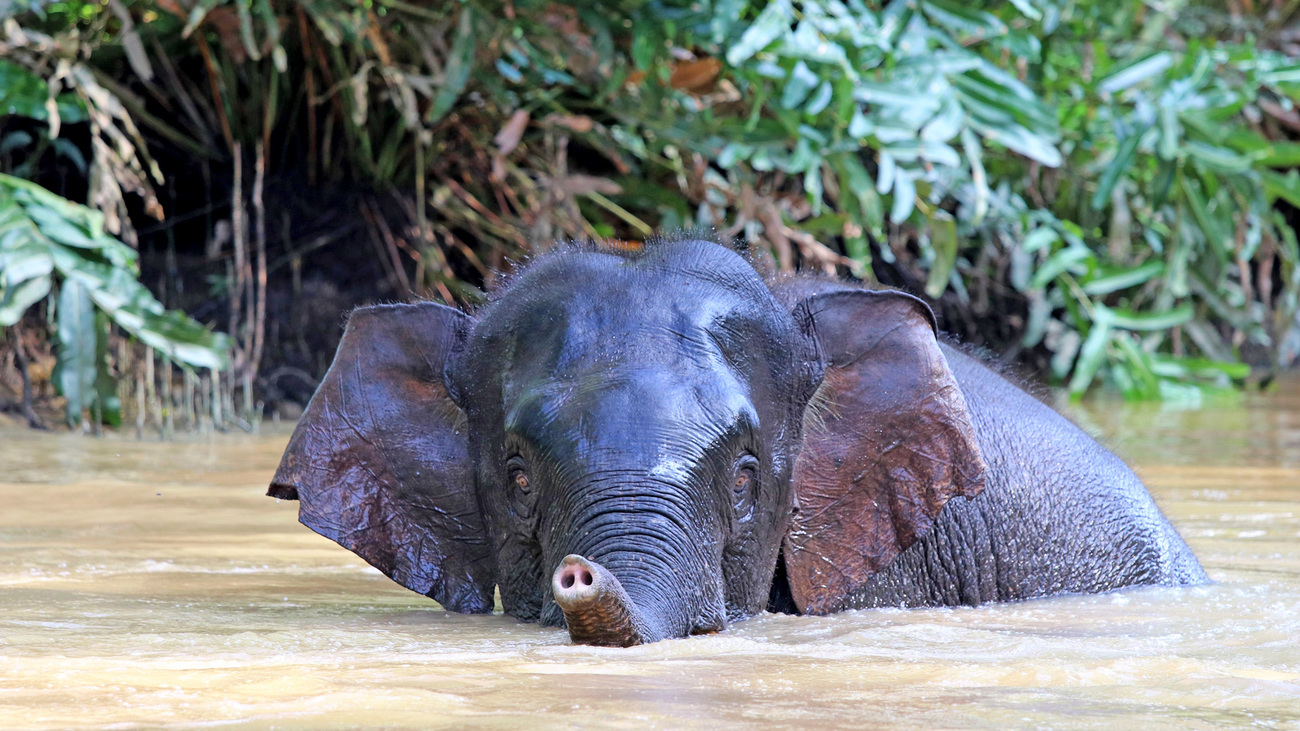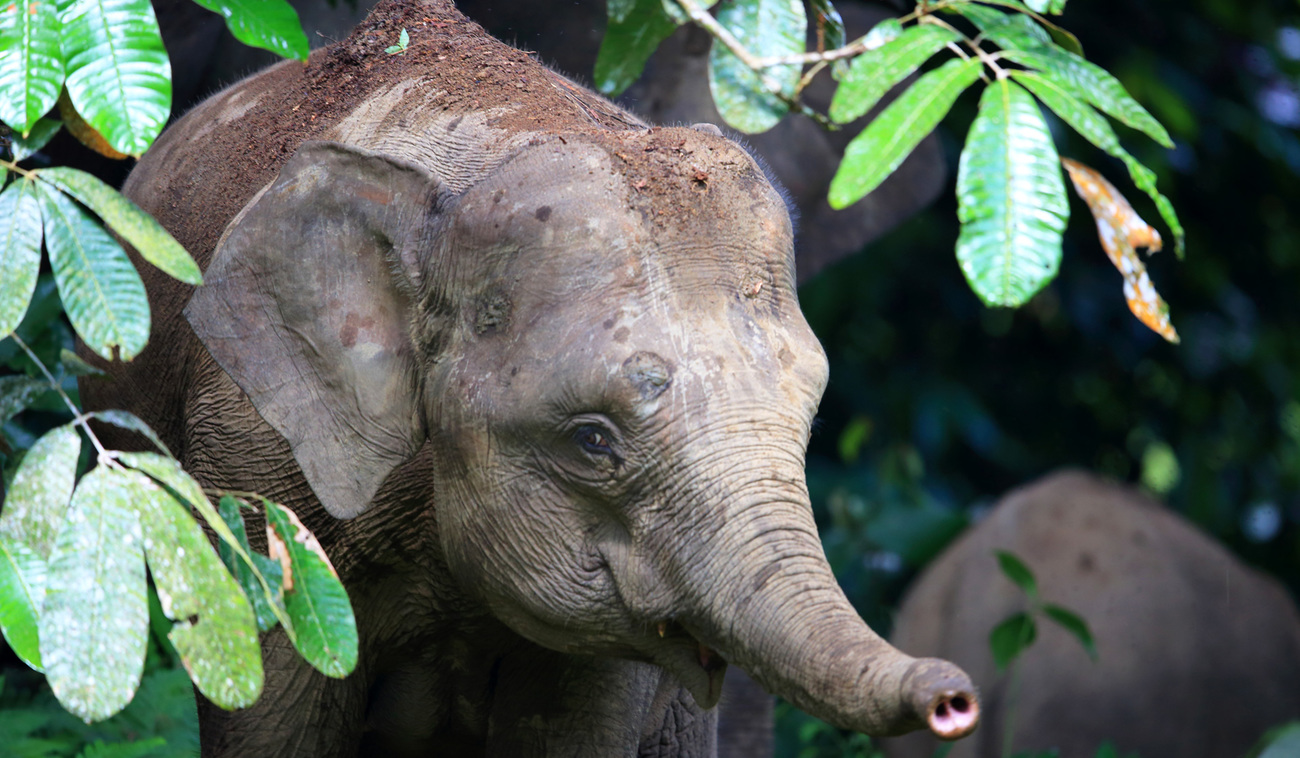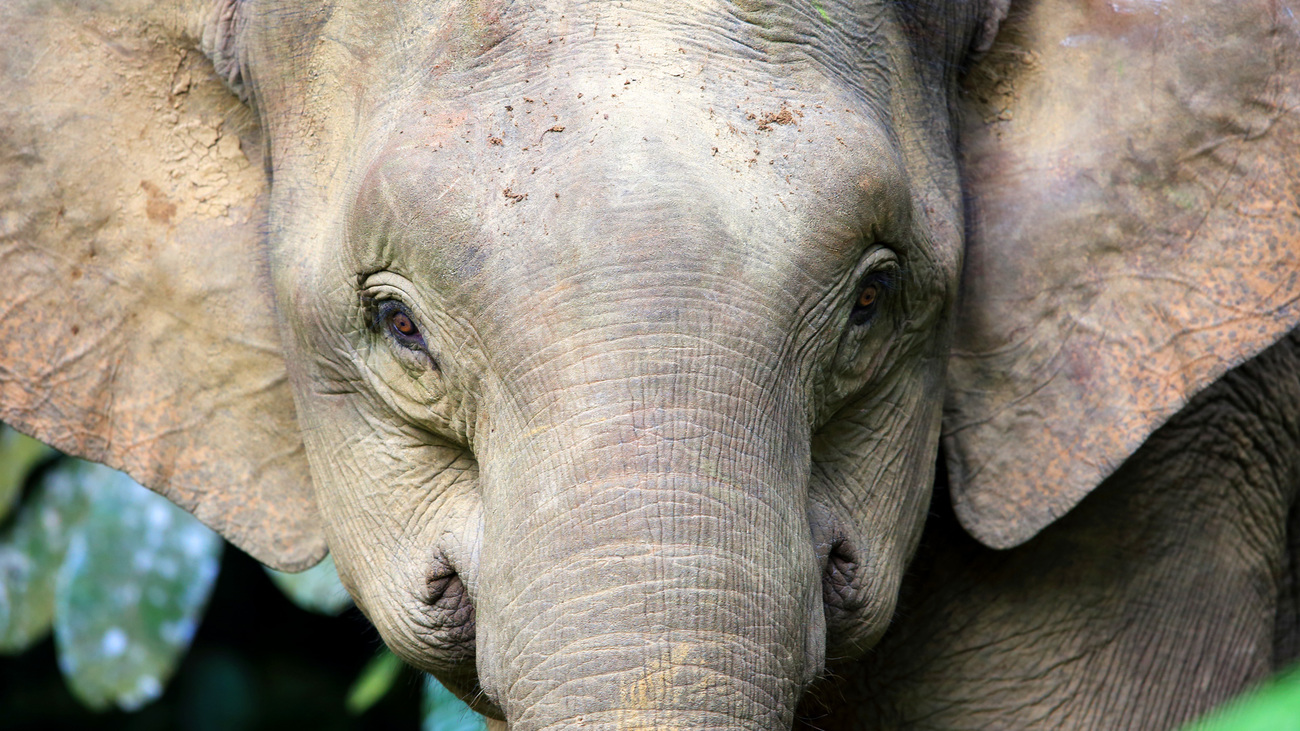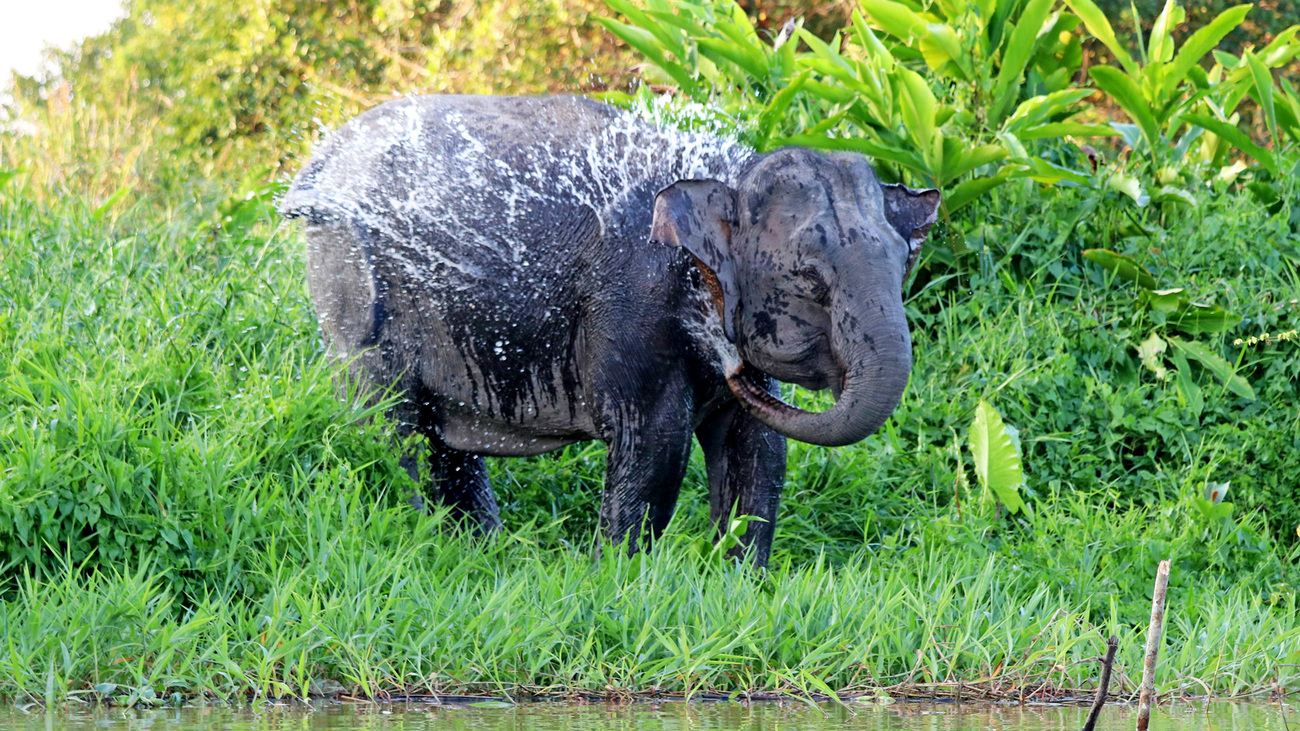Borneo elephants
Borneo elephants are the smallest subspecies of Asian elephant, endemic to the island of Borneo. Sometimes called Borneo pygmy elephants, these relatively small mammals were separated from the rest of the continent’s elephants over 300,000 years ago and evolved to have different features due to their unique habitat.
Over time, Borneo elephants became smaller while developing proportionally larger ears, longer tails, and straighter tusks than other Asian elephants.
Borneo is the world’s third largest island, shared by Malaysia and Brunei in the north and Indonesia in the south. Borneo elephants primarily inhabit the island’s forests; however, their populations are under constant threat due to deforestation and other human activities.
Like other elephants across Asia and Africa, Borneo elephants are herbivores. Their diet consists of a variety of vegetation, including grasses, leaves, bark, and fruits.
As social animals, Borneo elephants live in family groups led by a matriarch. These family units are usually made up of about eight related individuals, including mothers, daughters, sisters, and immature males. When males reach maturity, they tend to live alone or form temporary bull herds.
Forming and existing in these groups are essential for the survival and well-being of the elephants, and help them navigate and adapt to their changing environment. These familial groups often gather together to maintain genetic diversity and the ongoing survival of their species.
Elephants have the longest gestation period of all mammals on Earth. A female Borneo elephant typically gives birth to a single calf after being pregnant for around 22 months. The birth of a calf is a significant event for the social group, and the responsibility of caring for and protecting the calf is shared among the group members.
As such a fragmented species with a population under 1,500, scientists don’t know much about the mating and reproductive behaviors of Borneo elephants. It’s believed that young elephants wean off their mothers’ milk at around four months old and reach sexual maturity when they are 10 years old.
These island-dwelling elephants are known to roam large distances, sometimes covering up to 40 kilometers (25 miles) in a day. This constant movement is crucial in helping to maintain the health and diversity of their ecosystems. As they roam through the forestland, they disperse seeds through their dung over large areas, promoting plant growth and contributing to the regeneration of the forest.
As huge, lumbering animals that cover a lot of ground, Borneo elephants create clearings and pathways in the forest, which influences the distribution of plant species and helps smaller animals reach food and water sources.
The presence of elephants in an ecosystem can have a positive impact on climate regulation. Influenced by the activities of elephants, forests store carbon and help mitigate climate change. The disturbances caused by elephants’ movements can create microhabitats that benefit various plant and animal species.
Borneo elephants face numerous threats, including habitat loss, fragmentation, and human-wildlife conflict. Since 1986, the Asian elephant has been listed as endangered on the IUCN Red List, and their population has declined by at least 50% over the last three generations.
As their habitats are increasingly encroached upon by humans, conservation efforts are crucial to ensure the survival of these elephants and the ecosystems they inhabit.
What is a Borneo elephant’s scientific name?
The scientific name for the Borneo elephant is Elephas maximus borneensis. It is a subspecies of the Asian elephant (Elephas maximus) and is specifically native to the island of Borneo, which is where borneensis comes from.
Are Borneo elephants endangered?
Asian elephants as a species have been listed as endangered on the IUCN Red List since 1986. However, as a small subspecies localized to one island, there seems to be little data on Borneo elephants specifically.
Where do Borneo elephants live?
As the name suggests, Borneo elephants primarily live on the island of Borneo—located in Southeast Asia and shared between Indonesia, Malaysia, and Brunei.
They live in the forested land on the island, including rainforests, montane forests, and wetland peat swamp forests. They typically are found near water sources, such as rivers.
Threats
Unfortunately, the habitat of Borneo elephants has been significantly impacted by human activities such as logging, agriculture, and human settlement. Habitat loss and fragmentation pose significant threats to the survival of these elephants. Conservation efforts are essential to protect their remaining habitats and ensure the long-term survival of the Bornean elephant population.

Habitat loss
Forests across Borneo are being destroyed for human agriculture, wiping out the areas where Borneo elephants have lived for millennia.
As the human population of Borneo expands, deforestation has increased for purposes of agriculture, logging, and infrastructure development, leading to the fragmentation and degradation of the elephants’ natural habitats.
Habitat loss poses a severe threat to Borneo elephants as it directly impacts their ability to find sufficient food, water, and suitable living conditions. As forests are cleared, the elephants’ traditional migration routes and foraging areas are disrupted, leading to conflicts with humans as they venture into cultivated areas in search of resources.
Habitat loss also affects the biodiversity of the elephants’ environment, affecting the availability of essential food sources and disrupting the delicate balance of their ecosystem. It can fragment populations, isolating elephants from others of their species. This can prevent them from having enough genetic diversity to continue reproducing.
Poaching
Like other elephant species, Borneo elephants are hunted for their tusks and skin. Despite measures being introduced to clamp down on the ivory trade, an illegal market still flourishes.
The illegal ivory trade is a complex network, making it difficult for authorities and conservationists to effectively combat poaching. The loss of elephants to poaching disrupts the delicate social structures within their family groups and can have cascading effects on the overall population and their ecosystems.
Robust anti-poaching measures, international collaboration, and community involvement are crucial components of conservation strategies to protect Borneo elephants from the devastating impact of poaching and ensure their long-term survival.
Low genetic diversity
Borneo elephants are already a very small population. Add to this the distinct and very real threats posed by habitat loss and poaching, they are an increasingly fragmented population. As groups of Borneo elephants are cut off from one another, their genetic diversity decreases to unsustainable levels.
This leads to inbreeding, which, evolutionarily speaking, leads to the expression of harmful recessive traits. Borneo elephants who are breeding within their families may see problems with offspring, as low genetic diversity increases their vulnerability to diseases and reduces their ability to adapt to environmental changes.
This makes it very difficult for Borneo elephants to continue as a healthy and flourishing species. To address this threat, conservation efforts need to focus on maintaining and restoring habitat connectivity.
FAQs
Borneo elephants are something of an elusive subspecies, not often observed in the wild thanks to their low population numbers and fragmentation within their habitat. Here are some facts about Borneo elephants that we do know.
Are there elephants in Borneo?
Yes, the island of Borneo is home to a unique subspecies of Asian elephant called the Borneo elephant. These creatures have been isolated on the island of Borneo for about 300,000 years and have evolved to be smaller than other elephants on the mainland.
Borneo elephants are primarily found in the tropical rainforest in the northwest of the island, on land that belongs to Indonesia and Malaysia.
While some scientists believe Borneo elephants were introduced to the island in the 18th century by the Sultan of Sulu, it’s far more likely that they are indigenous to the island and pre-date human populations.

What do Borneo elephants eat?
Like other elephants, Borneo elephants are herbivores. Their diet consists of:
- Grasses, on which they graze in grassy areas of their habitat
- Leaves, which they pluck from branches with their trunks
- Bark from trees when other food sources are scarce
- Fruits, which enables elephants to contribute to seed dispersal
- Any other plants and vegetation in their habitats, depending on seasonal and environmental factors
Their feeding habits are not only essential for their own nutrition but also play a crucial role in shaping the structure and composition of the forest ecosystem. As they move through their habitats, elephants contribute to seed dispersal, helping to maintain the biodiversity and regeneration of plant species in the forest.
How big are Borneo elephants?
Borneo elephants are smaller than the Asian elephants from which they evolved, which leads to some calling them Borneo pygmy elephants.
Adult male Borneo elephants typically stand about 2.5 to 3 meters (8.2 to 9.8 feet) tall at the shoulder, while females are slightly shorter.
For comparison, male Asian elephants can stand up to four meters (just over 13 feet) tall at the shoulder.
How much do Borneo elephants weigh?
Adult male Borneo elephants weigh 2,950 to 5,000 kilograms (6,600 to 11,000 pounds).
How long do Borneo elephants live?
In the wild, Borneo elephants have a fairly long life expectancy of 55 to 70 years.
However, factors such as environmental conditions, availability of resources, and threats from human activities can influence the overall health and longevity of individuals within a population. Estimating the exact age of an elephant in the wild can be challenging, especially for a fragmented subspecies like the Borneo elephant.
Are Borneo elephants endangered?
Yes, Borneo elephants are considered endangered due to various threats that have significantly impacted their populations. The main threats to Borneo elephants include:
Habitat loss and fragmentation
The expansion of human activities, such as logging, agriculture, and infrastructure development, has led to extensive habitat loss and fragmentation. This disrupts the elephants’ traditional migration routes, foraging areas, and social structures.
Human-wildlife conflict
As elephants’ natural habitats are encroached upon by human activities, they often come into contact with human settlements, leading to conflicts. Elephants may damage crops, and retaliatory measures by humans can result in injury or death to both elephants and people.
Poaching
Illegal poaching for ivory remains a significant threat to elephants. They are targeted for their tusks, which are highly valued in the illegal wildlife trade. Poaching disrupts social structures and can have long-term impacts on population dynamics.
Low genetic diversity
Borneo elephants face challenges related to low genetic diversity, which makes them more susceptible to diseases and reduces their ability to adapt to changing environmental conditions.
Conservation efforts are crucial to address these threats and ensure the survival of Borneo elephants. These efforts include habitat protection, sustainable land use practices, mitigating human-elephant conflicts, and combating illegal poaching and the ivory trade.
How many Borneo elephants are left in the world?
Borneo elephants are a very fragmented population, so it’s hard for scientists and conservationists to provide an exact number of how many individuals are left in the wild.
The last figure released, in 2021, reported there to be less than 1,500 wild Borneo elephants remaining.

How can you help?
Borneo elephants are in very real danger of becoming an extinct subspecies in the coming decades. To protect this vulnerable species, extensive conservation efforts are needed to ensure the survival of the remaining elephants.
